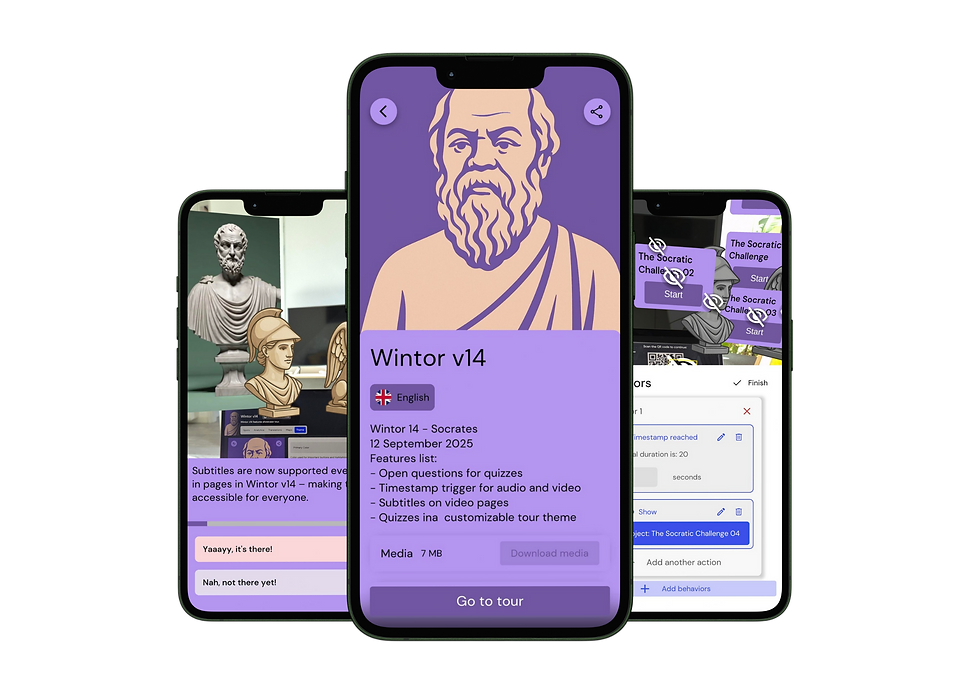360 tour versus AR tour: what's the difference?
- Wouter Kayser

- Jan 2, 2023
- 4 min read

360 tours and augmented reality (AR) tours are two technologies that are commonly used to provide immersive virtual experiences. While both technologies allow users to explore environments, they differ in a number of key ways. In this article, we will explore the differences between 360 tours and AR tours, including how they work, the benefits of each technology, and the ways in which they can be used.
What are 360 tours, also known as virtual tours?
360 tours, also known as virtual tours, are 3D models or 360 -photos and -videos of real-world environments that users can explore using a computer or mobile device. These tours are designed to provide a realistic representation of a space, allowing users to experience the environment as if they were physically present. One of the most used examples is Google's Streetview.
Software to create virtual tours
You can create a virtual tour using 360 photos or by 3D scanning an environment. A well-known tool to create tours using 360 photos is 3D-vista. The best-known 3D scanning virtual tour software is Matterport.
How to access a virtual tour
The resulting tour can then be accessed by users via a web browser or mobile app, allowing them to navigate through the tour using their device's screen. By moving their device, users can look around the virtual space and explore it from different angles. On a computer, users can use their mouse an keyboard.
Advantages
One of the main advantages of 360 tours is that they can be created without the need for any coding or programming knowledge. This makes them accessible to a wide range of users, including businesses, real estate agents, and individuals who want to share their spaces with others. 360 tours can be used for a variety of applications, such as showcasing a property for sale, providing virtual tours of a museum or tourist attraction, or giving users a virtual preview of an event venue.
What are AR tours?
Augmented reality (AR) tours are a type of virtual experience that combines the real world with virtual elements. AR tours use a device's camera to superimpose virtual objects or information onto the user's view of the real world. This creates the illusion that the virtual elements are actually present in the physical space.
Example of an AR tour
For example, an AR tour might allow users to explore a virtual museum exhibit by displaying 3D models of artifacts on their device's screen as they walk around a physical museum. The virtual elements would appear to be present in the physical space, allowing users to interact with them as if they were real. In the following video, you will find an example of the National Military Museum which used an AR tour to give users additional information about the exposition, without adding physical signs or information to the museum.
Software to create AR tours
AR tours can be created using various software tools, including no-code platforms that allow users to build AR experiences without any coding knowledge. An example of this is Wintor. This makes AR tours an accessible option for businesses and individuals who want to create immersive virtual experiences that interact with the real world.
Advantages
AR tours have a number of potential applications, including education, tourism, and real estate. For example, an AR tour could be used to provide virtual guided tours of a historical site, allowing users to learn more about the location as they walk around. AR tours could also be used to provide virtual try-ons of products in a retail setting, allowing customers to see how an item would look on them before making a purchase.
Another huge advantage is that you can use the mobile phones of the visitors to run the experience.
Key differences between 360 tours and AR tours
There are a couple of differences between the two regarding the interactivity and the immersion they provide. But actually the most important difference is that virtual tours give an experience of a location to people at home, an AR tour gives an experience at a location.
It's all about the location
As an example of this: you can visit the Louvre museum using their virtual tour while sitting at home. But when you are physically at the Louvre, you can get more insights and information using an AR tour. That is why some organisations don't simply rely on one of the two, but they offer both options. An AR tour and a virtual tour can co-exist together well.
Hardware requirements
A virtual tour typically runs on a desktop computer or a mobile phone, usually within a browser. Sometimes these virtual tours run on virtual reality (VR) headsets.
An AR tour needs a mobile phone or tablet to run, because it would need a device with a screen and camera. There are also AR tours running on AR or MR glasses, such as the hololens. The Natural History Museum used it to bring extinct animals back to life.
Conclusion
Ask yourself the question: where is my visitor and how would I like to guide them? Is your visitor at home, use a virtual tour. Is your visitor at your location, use a augmented reality tour. The article gives some examples, but it's always best to try it yourself. If you want to try to create your own AR tour: give Wintor a try.



Comments